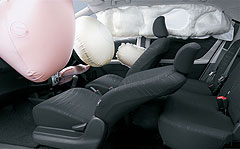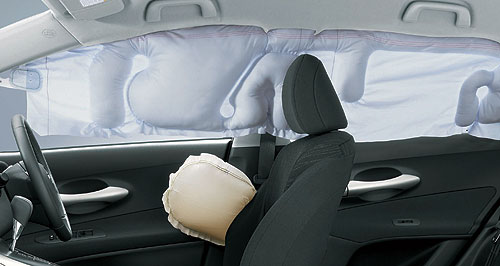Make / Model Search
News - General NewsAustralia takes side-impact safety leadHead first: Side and curtain airbags might be fitted to every car under proposed new international side-impact standards supported by Australia. Government proposes global side-impact standard as industry crafts head airbag code7 May 2010 By TERRY MARTIN THE Australian car industry has welcomed the federal government’s proposal for an international side-impact standard for vehicles, which would require a minimum standard for vehicle performance in a so-called pole crash and could prompt head-protecting side/curtain airbags to be fitted on all new vehicles sold in this country. Federal transport minister Anthony Albanese said this week that the proposal would be formally considered by the UN’s international standards working group in June. This course of action is in keeping with the Rudd government’s policy to harmonise Australian Design Rules (ADRs) with United Nations Economic Commission for Europe (UN ECE) vehicle regulations, which it acknowledges as the peak international standards. Road safety authorities, including the NCAP crash-test regime, have been calling for the mandatory head-protecting side and curtain airbags for years. According to Mr Albanese, the proposed side-impact standard is an example where Australia was setting the agenda in vehicle safety.  Left: Toyota Yaris safety cell. Left: Toyota Yaris safety cell.The minister also urged the Federal Chamber of Automotive Industries (FCAI) to finalise its voluntary code of practice on head-protecting side airbags, which he said would support the government’s proposed standard. Under the code, the industry is aiming for 80 per cent of new vehicles to have head-protecting side airbags installed by 2012 – with 100 per cent by 2016. “Australia is currently mounting a proposal for development of an international pole side impact standard aimed at increasing vehicle occupant protection,” said Mr Albanese, pointing to the fact that up to 10 per cent of Australian road fatalities involve pole side impacts. “I strongly urge the FCAI and it members to support Australia’s proposal and to recommend this position to the International Organisation of Vehicle Manufacturers. “I also look forward to the FCAI finalising the voluntary code of practice on head-protecting side airbags as soon as possible. “Most new vehicles sold in Australia already have this safety feature, but I encourage (car companies) to go further and ensure it is made available to lower specification vehicles as well and to reflect such a commitment clearly in the code. “This will complement Australia’s Geneva proposal and demonstrate industry’s commitment to lead on safety.” In response, FCAI chief executive Andrew McKellar told GoAuto that the industry supported the government’s Geneva initiative and was expecting to soon finalise its side-airbag code of practice. “The technical provisions in it are pretty much finalised. I think what we need to do is really ensure that we work on the presentation of that and ensure that the key messages are there, and I think that can be finalised in very short order,” Mr McKellar said. “Brands recognise that with things like ESC and head-protecting side airbags – and safety equipment in general – that people do value it. There is competition there to provide safer vehicles in the market – we’re seeing that occur naturally – but the issue here is that at the moment there is no global standard, or global regulation. “The Australian government is going to the UN ECE in Geneva supporting the development of a global standard, and the industry has thrown its support behind the government on that point. “We are supporting what the Australian government and other governments are putting forward in terms of the global standard on head-protecting side airbags.” Mr Albanese said the government was making a concerted effort to increase its involvement in the creation of global vehicle standards. Referring to the Victorian government’s controversial move to legislate for mandatory electronic stability control (ESC) for all new cars and SUVs sold in the state from 2011, which is almost a year earlier than the proposed national rollout, the federal transport minister also said the government was determined to ensure Australia took a national approach to vehicle standards. “It is in everybody’s best interests for standards to be clear, unequivocal and national,” Mr Albanese said. “Given that over 80 per cent of vehicles are imported into Australia, it is also vitally important that the ADRs be harmonised as much as possible with the United Nations Economic Commission for Europe. “In October last year, the Victorian government announced that it would mandate the fitting of ESC to all new light passenger vehicles from January 2011 through its own local regulations. “In a national market where there was already a very strong take-up of ESC, the benefits in doing so are minimal while the costs are significant. “I will continue to argue that it is vitally important that in areas such as vehicle standards, we must support a national approach. “An important element in ensuring we maintain a robust national approach is for the Australian government and vehicle industry together to demonstrate clear and decisive leadership, in setting the vehicle safety agenda. “My department is currently working on reinvigorating the Technical Liaison Group, the peak ADR advisory forum which includes the FCAI, the states and territories and other industry groups, so that it has a more strategic focus and achieves greater levels of ‘buy in’ from all participants. “The government has also directed the department to increase its involvement in the formulation of international vehicle standards.” As spokesperson for Mr Albanese also told GoAuto that the government was continuing to watch UN ECE movements on legislating mandatory fitment of ESC for light commercial vehicles (LCVs). “We’re looking at it in the context of what’s happening internationally,” the spokesperson said. “When it comes to these things, simply because 80 per cent of our cars are imported, Australia doesn’t seek to lead the world – we seek to maintain consistency with best practices around the world. “When we’ve got something to say on that (ESC for LCVs), we’ll say it.”  Read more23rd of November 2009  Hit the skids on ESC, Canberra tells VicsFederal minister tries softly-softly approach to pull Victorian ESC rule into sync20th of July 2009  Re-think on compulsory ESC for LCVsAlbanese reviews decision not to include utes, vans in new ESC laws |
Click to shareGeneral News articlesResearch General News Motor industry news |











Facebook Twitter Instagram